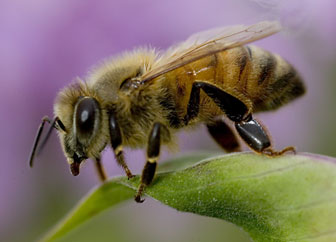Mysterious outbreak killing millions of bees
Mysterious outbreak killing millions of bees
mongabay.com
February 14, 2007
An mysterious outbreak is causing the deaths of millions of honeybees in 22 states according to an entomologist from the University of Montana.
Jerry Bromenshenk says that Colony Collapse Disorder (CCD) is “causing agricultural honeybees nationwide to abandon their hives and disappear.”
“Individual beekeepers are really taking a beating,” Bromenshenk said. “A guy down in Oklahoma lost 80 percent of his 13,000 colonies in the last month. In Florida, there are a whole lot of people facing 40, 60 and 80 percent losses. That’s huge.”

A honeybee settles onto a wildflower at Fermilab. Image courtesy of the Fermi National Accelerator Laboratory |
“With CCD, most adult honeybees abandon a hive and disappear, leaving the queen and a remnant of younger bees. The malady also is characterized by uncapped brood — when the cells of young bees in the pupa stage are not covered and protected by their older sisters — probably because most of the adult bees have left. Dead adult bees aren’t found near the hive; they are just gone,” explains a news release from the University of Montana.
Bromenshenk says that similar outbreaks date back as far as 1896, though the last major outbreak probably occurred in the 1960s.
“My belief is that what’s going on right now has been seen before, but we’ve never really gotten a handle on it,” he said.
Bromenshenk has formed a team from the University of Montana that will work with a group of Penn State scientists to better understand the outbreak, which could have a major impact on agricultural production in some areas.
Related news
Bees and flowers disappearing together. The diversity of bees and of the flowers they pollinate, has declined significantly in Britain and the Netherlands over the last 25 years according to research led by the University of Leeds and published in Science this Friday (21 July 2006). The paper is the first evidence of a widespread decline in bee diversity.
Animal pollinators responsible for 35 percent of world food crop. A new study calculates that 35 percent of the world’s crop production is dependent on pollinators, like bats, bees, and birds. The research suggests that biodiversity loss could directly impact global food crops. The study comes a week after another report found declines in populations of key North American pollinators
This article uses quotes and information from a University of Montana news release.







